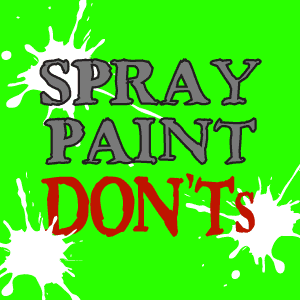 not the charm for me, but I’m pretty sure the next time I’ll be more successful because I made ALL THE MISTAKES possible already.
not the charm for me, but I’m pretty sure the next time I’ll be more successful because I made ALL THE MISTAKES possible already.
Spray painting tips (borrowed from Krylon’s website; my DON’Ts are in green):
- Choose your location. Make sure you work in a well–ventilated area. Spray outdoors whenever possible or when using spray paint indoors, make sure the area is well-ventilated by opening doors, windows or using a fan. Avoid painting in direct sunlight and in hot, humid weather.
DON’T: use your windowless laundry room with the door closed (so overspray doesn’t end up on the hardwood floor in the hall), even if you’re using a fan. A fan will blow all the neon green paint particles around the room and onto every surface, including your walls, tables, expensive washer and dryer, bamboo floor mat, sink surround, electric cords, linoleum floor, clothes, hair, skin, bottom of feet, white towels, dirty clothes, and stainless steel table). And the hairdryer that I thought would help speed the dry time ended up in the garbage because the vent got covered in the paint and it won’t come off. - Protect from overspray. Overspray can occur both indoors and outdoors. To prevent overspray onto other surfaces, use newspapers, painter’s tape or drop cloths to cover surrounding areas. You can also create your own “spray booth” by turning a large cardboard box on its side and place objects inside when spraying.
DON’T: think that all that plastic sheeting you taped against the wall, table, and up the sides of your paint area will hold your neon green spray paint. Those little buggers thought my “spray booth” was the entire laundry room (thank goodness I closed the door – I may have ruined my lungs but at least I protected my hardwood floors.) - Prepare the surface of your project. Paint only clean, dry surfaces. Ordinary household detergents or mineral spirits are great for most surface cleaning. Glossy or hard surfaces should be sanded to improve adhesion. Use a primer whenever possible as it creates a clean, smooth surface, increases paint adhesion, seals the surface and ensures the true paint color is achieved.
DON’T: use a bristle brush and paint stripper on a vintage metal item because those tiny flecks that hit the wall, fixtures, washer/dryer, and bamboo floor mat probably contain deadly lead paint and is a beast to get unstuck. - Read all directions. Before beginning your project, thoroughly read all directions on the can. Pay particular attention to safety tips and recoat times. Always follow label directions and warnings when using any aerosol paint.
DON’T: figure that just reading the directions means you’ve absorbed them and will follow them properly. Pay attention. - Test your spray paint. Shake the can vigorously before spraying. Test your paint or spraying technique in an inconspicuous area or on a piece of scrap material before beginning your project.
DON’T: be overambitious and skip this test. Luckily me skipping it this time didn’t ruin my project. Everything else did, but not this one. - Apply multiple thin coats. Once you have completed your paint test and are satisfied, spray your project using several thin, multiple coats instead of one thick coat. Begin and finish your spray pattern off the object, releasing the button at the end of each pass. Use an even side-to-side motion with each pass overlapping your spray pattern by about one-third. For best results, always apply a coat to the entire project as opposed to completing parts of the project in stages.
DON’T: think they’re kidding, they’re not. I’m kind of impatient and impatience equals a thick coat that dribbles like candle wax. - Allow project to dry. Check the directions on the back of the can for a recoat window. A recoat window identifies when additional coats can be applied within a certain timeframe. When you are finished applying all coats, do not handle the project or surface until it is dry.
DON’T: expect the paint gods to smile upon you and let you pick up the project so you can move it to a secret hiding spot to finish drying. Leaving your fingerprint on Santa’s gift to your child is evidence admissible in a court of North Pole law. - Clean spray valve after use. Before storing your aerosol cans for future use, clean the spray valve by turning the cans upside down and spraying for 5 seconds. This helps prevent the spray tip from clogging.
DON’T: worry about getting to this step because, if you’re like me, you’ll run out of paint just before you’ve finished the last two inches. (By the way, cursing absolutely DOES please the paint gods because that last 2″ got barely covered… barely.) - Celebrate your success. Enjoy your newly painted project. Feel good about yourself knowing that with a little work and very little money, you were able to finish your project.
DON’T: expect too much pride or pats on the back when you’re not ever going to get credit for all that work and mess because a fat guy in a red suit that breaks into your house once a year will get all the glory.
Which reminds me of that one time I made myself a dress from scratch. ONE TIME because it was not worth it when I could get a dress at Ross on clearance for under $15. Sometimes it’s best to pay a professional to do the job right.
10. Save spray painting projects for warmer weather. This is my personal tip. Don’t spray paint indoors (unless you’re a professional with proper gear), even if you think opening a door is enough ventilation (it is not), do it outside (if in the garage, the door must be open). Even though you think you’ve protected all surrounding surfaces with plastic, you didn’t do it well enough. It’s preferred to be completely outside, in decently warm weather, where all those noxious fumes can go into the atmosphere (instead of in your lungs) and contribute to global warming with the ozone-killing can (at least that’s what the internet tells me).
I am new at the pinning of my stuff on Pinterest, so I wonder if you’d pin this post if you think the tips would be helpful to others? Thanks!
{ Comments on this entry are closed }










